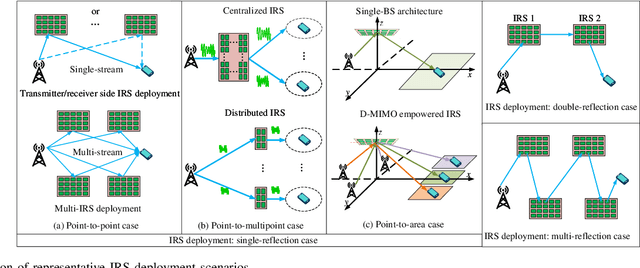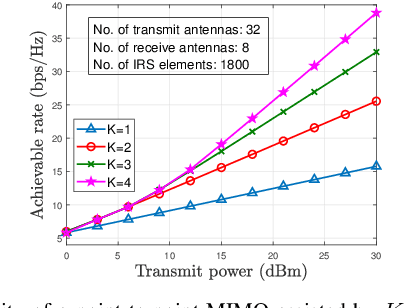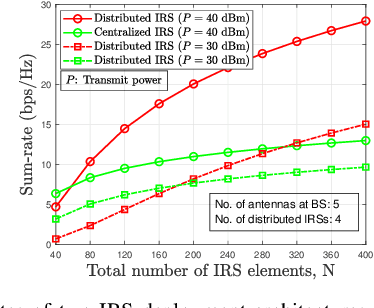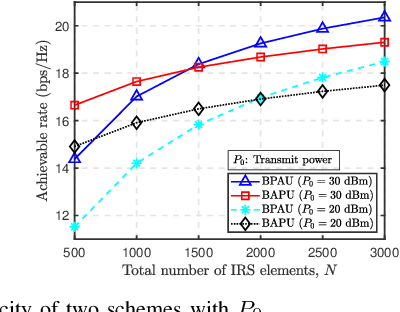Jianwu Dou
Experimental Performances of mmWave RIS-assisted 5G-Advanced Wireless Deployments in Urban Environments
Jun 06, 2025



Abstract:Reconfigurable intelligent surface (RIS) has emerged as a groundbreaking technology for 6G wireless communication networks, enabling cost-effective control over wireless propagation environment. By dynamically manipulating its codebook so as to deflect the direction of the reflected electromagnetic wave, RIS can achieve enhanced signal quality, extended coverage, and interference mitigation. This study presents experimental performance of ZTE Dynamic 2.0 RIS products through a series of real-world tests conducted on Turkcell's millimeter-wave (mmWave) testbed. The evaluation involves network coverage extension in urban areas, multi-user efficiency, and the integration of virtual reality technology to support immersive applications in next-generation 6G networks. Through a comprehensive measurement-based analysis, the performance of the RIS product is demonstrated, highlighting its potential to address critical challenges in mmWave communications and to enable advanced 6G use cases.
Intelligent Reflecting Surfaces Aided Wireless Network: Deployment Architectures and Solutions
Jan 15, 2025



Abstract:Intelligent reflecting surfaces (IRSs) have emerged as a transformative technology for wireless networks by improving coverage, capacity, and energy efficiency through intelligent manipulation of wireless propagation environments. This paper provides a comprehensive study on the deployment and coordination of IRSs for wireless networks. By addressing both single- and multi-reflection IRS architectures, we examine their deployment strategies across diverse scenarios, including point-to-point, point-to-multipoint, and point-to-area setups. For the single-reflection case, we highlight the trade-offs between passive and active IRS architectures in terms of beamforming gain, coverage extension, and spatial multiplexing. For the multi-reflection case, we discuss practical strategies to optimize IRS deployment and element allocation, balancing cooperative beamforming gains and path loss. The paper further discusses practical challenges in IRS implementation, including environmental conditions, system compatibility, and hardware limitations. Numerical results and field tests validate the effectiveness of IRS-aided wireless networks and demonstrate their capacity and coverage improvements. Lastly, promising research directions, including movable IRSs, near-field deployments, and network-level optimization, are outlined to guide future investigations.
A 3D Modeling Method for Scattering on Rough Surfaces at the Terahertz Band
May 05, 2023



Abstract:The terahertz (THz) band (0.1-10 THz) is widely considered to be a candidate band for the sixth-generation mobile communication technology (6G). However, due to its short wavelength (less than 1 mm), scattering becomes a particularly significant propagation mechanism. In previous studies, we proposed a scattering model to characterize the scattering in THz bands, which can only reconstruct the scattering in the incidence plane. In this paper, a three-dimensional (3D) stochastic model is proposed to characterize the THz scattering on rough surfaces. Then, we reconstruct the scattering on rough surfaces with different shapes and under different incidence angles utilizing the proposed model. Good agreements can be achieved between the proposed model and full-wave simulation results. This stochastic 3D scattering model can be integrated into the standard channel modeling framework to realize more realistic THz channel data for the evaluation of 6G.
How Practical Phase-shift Errors Affect Beamforming of Reconfigurable Intelligent Surface?
Apr 13, 2023Abstract:Reconfigurable intelligent surface (RIS) is a new technique that is able to manipulate the wireless environment smartly and has been exploited for assisting the wireless communications, especially at high frequency band. However, it suffers from hardware impairments (HWIs) in practical designs, which inevitably degrades its performance and thus limits its full potential. To address this practical issue, we first propose a new RIS reflection model involving phase-shift errors, which is then verified by the measurement results from field trials. With this beamforming model, various phase-shift errors caused by different HWIs can be analyzed. The phase-shift errors are classified into three categories: (1) globally independent and identically distributed errors, (2) grouped independent and identically distributed errors and (3) grouped fixed errors. The impact of typical HWIs, including frequency mismatch, PIN diode failures and panel deformation, on RIS beamforming ability are studied with the theoretical model and are compared with numerical results. The impact of frequency mismatch are discussed separately for narrow-band and wide-band beamforming. Finally, useful insights and guidelines on the RIS design and its deployment are highlighted for practical wireless systems.
A Ray-tracing and Deep Learning Fusion Super-resolution Modeling Method for Wireless Mobile Channel
Jan 27, 2023



Abstract:Mobile channel modeling has always been the core part for design, deployment and optimization of communication system, especially in 5G and beyond era. Deterministic channel modeling could precisely achieve mobile channel description, however with defects of equipment and time consuming. In this paper, we proposed a novel super resolution (SR) model for cluster characteristics prediction. The model is based on deep neural networks with residual connection. A series of simulations at 3.5 GHz are conducted by a three-dimensional ray tracing (RT) simulator in diverse scenarios. Cluster characteristics are extracted and corresponding data sets are constructed to train the model. Experiments demonstrate that the proposed SR approach could achieve better power and cluster location prediction performance than traditional interpolation method and the root mean square error (RMSE) drops by 51% and 78% relatively. Channel impulse response (CIR) is reconstructed based on cluster characteristics, which could match well with the multi-path component (MPC). The proposed method can be used to efficiently and accurately generate big data of mobile channel, which significantly reduces the computation time of RT-only.
A Multi-Task Learning Model for Super Resolution of Wireless Channel Characteristics
Sep 09, 2022Abstract:Channel modeling has always been the core part in communication system design and development, especially in 5G and 6G era. Traditional approaches like stochastic channel modeling and ray-tracing (RT) based channel modeling depend heavily on measurement data or simulation, which are usually expensive and time consuming. In this paper, we propose a novel super resolution (SR) model for generating channel characteristics data. The model is based on multi-task learning (MTL) convolutional neural networks (CNN) with residual connection. Experiments demonstrate that the proposed SR model could achieve excellent performances in mean absolute error and standard deviation of error. Advantages of the proposed model are demonstrated in comparisons with other state-of-the-art deep learning models. Ablation study also proved the necessity of multi-task learning and techniques in model design. The contribution in this paper could be helpful in channel modeling, network optimization, positioning and other wireless channel characteristics related work by largely reducing workload of simulation or measurement.
 Add to Chrome
Add to Chrome Add to Firefox
Add to Firefox Add to Edge
Add to Edge